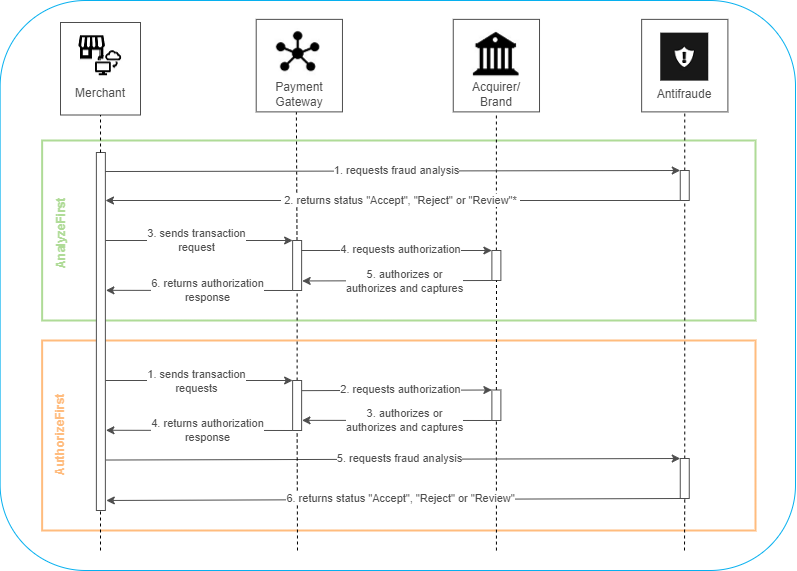Fraud analysis flows
The Antifraude Gateway forwards transaction data to an antifraud provider for analysis. Providers use technologies such as machine identification, IP geolocation, social media analysis, proxy detection and retry counters. Braspag receives a recommendation from the provider in real time and can then take action based on the fraud risk identified by the analysis.
There are two possible flows for fraud analysis:
- Fraud analysis first (AnalyzeFirst): all transactions are first subjected to Antifraude analysis and, if accepted, proceed to the acquirer's authorization process.
- Authorization first (AuthorizeFirst): All transactions are first submitted for authorization at the acquirer and, if authorized, are sent for Antifraude analysis.

*Review status is only returned if it is included in your plan.
Fraud analysis first (AnalyzeFirst)
- The merchant requests fraud analysis from Antifraude;
- Antifraude returns the status Accept, Reject or Review;
- The merchant sends the transaction request to the payment gateway;
- The payment gateway requests authorization from the acquirer;
- The acquirer authorizes the transaction or authorizes and captures;
Authorization First (AuthorizeFirst)
- The merchant sends the transaction request to the payment gateway;
- The payment gateway requests authorization from the acquirer;
- The acquirer authorizes the transaction;
- The payment gateway returns the authorization response;
- The store merchant fraud analysis from Antifraude;
- Antifraude returns the status Accept, Reject or Review.
The chosen flow must be determined during integration, because it is part of the application architecture.
If after integration you wish to change the fraud analysis flow, request Braspag support, as there are details involved in a possible change, especially in relation to speed rules.
AuthorizeFirst x AnalyseFirst
Check below the risk analysis behavior according to each type of integration:
Integration type | Description | Required parameters |
|---|---|---|
Authorize first | The transaction is sent for authorization and then analyzed by Antifraude. |
|
Analyze first | The transaction is analyzed by Antifraude and then sent for authorization. This way, high-risk transactions are not sent for authorization. |
|
Analysis of authorized transactions | Antifraude is triggered only to analyze authorized transactions, avoiding the cost of analyzing transactions that would not be authorized. |
|
Analysis under any circumstance | Antifraude is triggered regardless of the transaction status after authorization. |
|
Authorization under any circumstance | The transaction will be sent for authorization regardless of its fraud score. |
|
Authorization only for secure transactions | The transaction is sent for authorization only if Antifraude recommends acceptance. |
|
Capture of secure transactions | After the fraud analysis, capture will be automatic for authorized transactions classified as low risk. For merchants using manual review, the transaction will be captured automatically as soon as Braspag receives notification of the new status "Accept". |
|
Void compromised transactions | If the fraud analysis returns a high risk for a transaction that has already been authorized or captured, it will be immediately voided or refunded. For merchants using manual review, the transaction will be voided or refunded automatically as soon as Braspag receives notification of the new status "Reject". |
|
If not specified during authorization, Braspag will process your transaction using the following flow:
FraudAnalysis.Sequenceequals "AuthorizeFirst";FraudAnalysis.SequenceCriteriaequals "OnSuccess";FraudAnalysis.VoidOnHighRiskequals "false";FraudAnalysis.CaptureOnLowRiskequals "false".
Which flow is recommended for my e-commerce?
- The choice can be made according to the rules of your business, taking into account aspects such as the average ticket and type of product sold;
- You can assemble your application with both flows and apply business rules according to your risk criteria.
Check out some characteristics of each flow below, which can help you decide on the best model for your business:
Fraud Analysis First
- Antifraude will have visibility of e-commerce credit card transactions;
- Avoids early awareness of the credit card limit, avoiding friction/bad shopper experience;
- Promotes learning of the Antifraude engine;
- There is an analysis cost when the credit card used in the transaction does not have an available limit.
Authorization First
- Avoids the cost of analysis on credit card transactions that do not have an available limit;
- Antifraude has no visibility into unauthorized transactions.
Updated 16 days ago